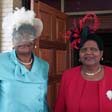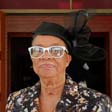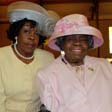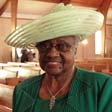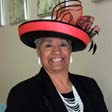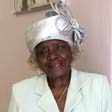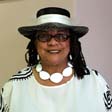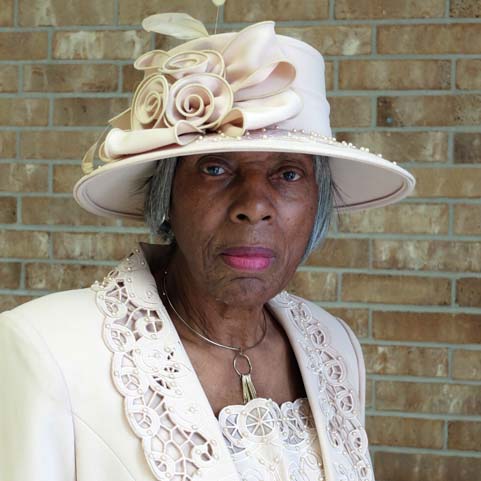Living in Style: The Language of Hats
By Laura Marcus Green
The saying is, and it's true—
a lady is never dressed without a hat.—Aldreamer Smith, Sensational Seniors,
Dr. Leo S. Butler Community Center

Inner and Outer Beauty: A Slideshow of Hats
Now they stroll up and down the aisles of the church, stars of splendor, beauty beyond measurement. Black ladies in hats.
—Maya Angelou, in Crowns; Portraits of Black Women in Church Hats
The weeks leading up to Easter were an opportune time not only to observe activity in the milliners' shops, but also to see women wearing their holiday finery. Women attending Palm Sunday and Good Friday services at the Shiloh Missionary Baptist Church wore an array of special hats and attire.
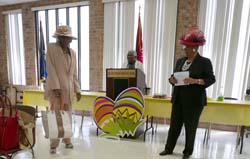
The Sensational Seniors group at the Dr. Leo S. Butler Community Center held a special Easter event, which included a devotional service and a Hat Day. The Hat Day featured a runway walk, for which those modeling their hats stopped and said a few words about their attire. Miss Aldreamer Smith, observed, "I'm the hat lady. I am never without a hat. The saying is, and it's true, 'A lady is never dressed without a hat.'" Mrs. Smith related that she has over a hundred hats and caps in her collection. Miss Rosa Pugh, another participant in the Hat Day activity observed, "The problem with us is, we don't see the beauty in ourselves." In her mint green and silver outfit, Miss Pugh emanated beauty both inside and out.
Conclusion
Hat-wearing traditions mirror changes in African American women's socio-economic status and their aesthetic and cultural practices over time. From their deep biblical and historical roots to today's media-driven trends, hats are an integral part of African American culture—whether as a reminder of mothers and grandmothers and their dignity and style, or as a current fashion statement. We live in complex times, where personal and cultural identity are continually negotiated at multiple levels. Perhaps this is always the case, with the benefit of hindsight. Although considered "old-timey" in some circles, black women's church hats are anything but. Whether a modest fascinator or a more elaborate crown, hats play a part in our most contemporary conversations about identity and relationships within family, community and broader society. Styles and wearing traditions may come and go. Yet, as a window onto our multifaceted lives, hats remain as relevant and illuminating—not to mention luminous—as ever.
Notes
1. The first lady is the pastor's wife.
2. Via email communication from Jacqueline Jones, July 2, 2018.
3. Among Jacqueline Jones's research sources is the following website: Louisiana's Code Noir (1724), http://www.blackpast.org/primary/louisianas-code-noir-1724
4. "A fascinator hat is a small ornamental headpiece that fits on the head using an alice-band-type base or headband or even a small comb. It is always lightweight and usually features feathers, beads or flowers. The use of the term fascinator began in the 1990s when such headpieces became popular for wearing at weddings without ruining your lovely hairstyle or giving you a helmet head." Source: http://visforvintage.net.
5. From "Jim Crow Laws," Wikipedia, https://en.wikipedia.org/wiki/Jim_Crow_laws.
6. Susan is referring to Hilton & Company Boutique, a prominent Baton Rouge milliner
Sources
Aguirre, Tony (Variety Fashion). 2015. Interviews by Laura Marcus Green, Baton Rouge. June 3.
Crenshaw, Jescenia. 2015. Interview by Laura Marcus Green, Baton Rouge. April 2.
Cunningham, Michael. 2000. Crowns; Portraits of Black Women in Church Hats. Doubleday.
Dickerson, Mu Kyong (Four Seasons Hat & Wig). 2015. Interview by Laura Marcus Green, Baton Rouge. March 31.
Green, Millie. 2015. Interview by Laura Marcus Green, Baton Rouge. March 30.
Attendees at Hat Day and Holy Week Devotion. 2015. Dr. Leo Butler Community Center, Baton Rouge. March 31.
Iyanu, Nomzamo and Jaqueline Jones. 2015. Interviews by Laura Marcus Green, Baton Rouge. April 2 and June 3.
Louisiana's Code Noir (1724). http://www.blackpast.org/primary/louisianas-code-noir-1724. Thanks to Jacqueline Jones for this reference.
N'Diaye, Diana. 2013. The Will to Adorn. https://folkways-media.si.edu/docs/festival/SFF13_Program%20Book_w2a.pdf
Nichols, Elaine. 2013. "Decked Out Accordingly: The Adornment of African American Women from Enslavement to the Mid-Twentieth Century," in The Will To Adorn. https://folkways-media.si.edu/docs/festival/SFF13_Program%20Book_w2a.pdf
Attendees at Palm Sunday and Good Friday services. 2015. Shiloh Missionary Baptist Church, Baton Rouge. 2015. March 29, April 3.
Self, Dafiney. 2015. Interview by Laura Marcus Green, Baton Rouge. March 27.
Thornton, Susan. 2015. Interview by Laura Marcus Green, Baton Rouge. March 31.



